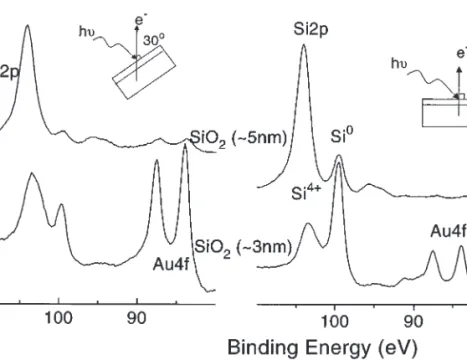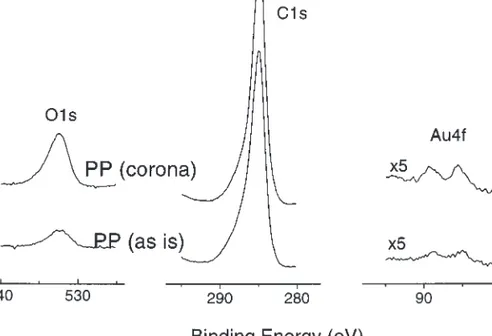COMMUNICATIONS
Reductive deposition of Au
3+
(aq) on oxidized
silicon surfaces
Ôefik Süzer and Ömer Dag
Abstract: X-ray photoelectron spectroscopy (XPS) is used to determine the oxidation state of gold deposited from an aqueous solution of AuCl4–on to various oxidized surfaces of silicon. Although the observed Au4f signal decreased with the thickness of the oxide layer, the oxidation state of Au was determined as 0 for all the samples analyzed. From the angular dependence of the Si2p and Au4f signals it was determined that Au is deposited on top of the oxidized surfaces of metallic silicon. It is postulated that from an aqueous solution of AuCl4–, gold would deposit in its zerovalent form on to any surface due to its large and positive electrochemical reduction potential (ε°red(Au3+/Au) = +1.50 V) and the substrate plays a role only in providing active deposition sites. To further support the proposal, it is shown that the same process takes place even in inert and hydrophobic polypropylene substrates. Similarly, it is also shown that more gold deposits if the surface of the polypropylene is made less hydrophobic (but probably more active) via the industrially used corona discharge treatment.
Key words: XPS, gold, electroless deposition, oxidized silicon surface.
Résumé : On a utilisé la spectroscopie photoélectronique aux rayons X pour déterminer l’état d’oxydation de l’or déposé à partir d’une solution aqueuse de AuCl4–sur diverses surfaces oxydées de silicium. Même si le signal observé pour Au4f diminue avec l’épaisseur de la couche d’oxyde, on a déterminé que l’état d’oxydation de l’or est égal à zéro pour tous les échantillons analysés. En se basant sur la dépendance angulaire des signaux Si2p et Au4f, on a déterminé que l’or se déposé au sommet des surfaces oxydées du silicium métallisé. On a fait l’hypothèse que, à partir d’une so-lution aqueuse de AuCl4–, l’or se déposerait dans sa forme zérovalente sur toutes les surfaces en raison de son potentiel de réduction électrochimique élevé et positif [ε°red(Au3+/Au) = +1,50 V]. Pour appuyer cette hypothèse, on montre que le même processus se produit même dans des substrats inertes et polypropyléniques hydrophobes. De la même manière, on a démontré qu’il y a plus d’or qui se dépose si la surface de polypropylène est rendue moins hydrophobe (mais probablement plus réactive) par le biais d’un traitement industriel par effluve.
Mots clés: spectroscopie photoélectronique à rayons X, dépôt sans électrode, surface de silicium oxydée. Communications 519
Introduction
Interest in the chemistry of gold has renewed due espe-cially to the ability of molecular self-assembly of aliphatic thiols on gold colloids (1) and also to form clusters in nm scales with potentially useful optical, optoelectronic, and material properties (2–4). Successful methods of preparation usually involve vapour-deposition or deposition from solu-tion via chemical and (or) electrochemical routes. An electroless deposition of zerovalent gold nano-clusters was reported using electroactive poly(3-alkylthiophenes) from a solution of the polymer and AuCl4– in nitromethane (5).
Similar studies were reported using other electroactive
poly-mers, such as, polyaniline and polypyrrole (6). The same group later reported on the uptake of gold and palladium from acidic solution of AuCl3and PdCl2 using electroactive
polymer-SiO2nano-composites (7). In a recent study it was
claimed that porous silicon could be utilized for reductive deposition of gold nano-clusters again from an aqueous so-lution AuCl4– (8). In our XPS investigation of metal ions
deposited on the surface of silica tubes for atom-trapping atomic absorption spectrometric determinations, we had also reported that Au was deposited in its zerovalent state both from the vapour phase of the flame and also from the aque-ous solution of AuCl4–(9). In a later study in which we had
also examined Mn and Bi, we claimed that reductive
deposi-Can. J. Chem. 78: 516–519 (2000) © 2000 NRC Canada
516
Received November 16, 1999. Published on the NRC Research Press web site on March 27, 2000
Ô. Süzer1and Ö. Dag. Bilkent University, Chemistry Department, 06533 Ankara, Turkey.
1Author to whom correspondence may be addressed. Telephone: 90-312-266-4946. Fax: 90-312-266-4579. e-mail: suzer@fen.bilkent.edu.tr
I:\cjc\cjc78\cjc-04\V00-039.vp Friday, April 14, 2000 8:02:39 AM Color profile: Disabled
tion of gold was mainly dictated by its electrochemical re-duction potential rather than the properties of the substrate (10). In this contribution we demonstrate this property of gold by depositing zerovalent gold from aqueous AuCl4–
so-lution on to different substrates.
Experimental
Si wafers with their polished surfaces are used to deposit gold from a dilute ca. 10–5M aqueous solution of AuCl4–. Si
samples were cut into 5 × 15 mm slices and cleaned by 10% HF before thermal treatment and analysis. Different oxide thicknesses were obtained by heating the substrate in air at different temperatures or for different periods. The sub-strates were then immersed into the solution for 10 h with-out stirring after which they were washed with acetone, dried in air, and inserted into the spectrometer. A Kratos ES300 spectrometer with MgK X-rays was used for XPS analysis. The X-ray anode power is kept below 40 W to re-duce the possibility of reduction under severe X-ray bom-bardment (11). SEM images were obtained using a Jeol 6400 electron microscope.
Results and discussion
Figure 1 displays the Si2p and Au4f region of the XPS spectra of gold deposited on to silicon wafers containing ap-proximately 3, 5, and 10 nm oxide layers and the relevant data are given in Table 1. One of the relevant observations in this investigation is that the oxidation state of gold is zero in all samples. Secondly, it is observed that the Au4f signal de-creases as thickness of the oxide layer is increased. At nor-mal electron take-off angle, the sampling depth of XPS using the MgKαX-rays is around 10 nm which can be fur-ther reduced by decreasing this electron take-off angle (11, 12). Figure 2 displays Si2p and Au4f signals recorded at normal (90°) and 30° electron take-off angles from two gold deposited samples containing ca. 3 and 5 nm oxide layers,
© 2000 NRC Canada
Communications 517
Binding energy (eV) and atomic abundances (in parenthesis)
Sample Si2p
Au4f7/2 Si° Si4+ C1s O1s
Si/SiOx(reference) — 99.7 102.4a (0.78) (0.22) Si/SiO2(~3 nm) 84.0 99.7 103.3a (0.03) (0.57) (0.43) Si/SiO2(~5 nm) 84.0 99.7 103.7a (0.02) (0.25) (0.75) Si/SiO2(~10 nm) 84.0 99.7 104.3a (0.01) (0.12) (0.88) PP (as is) 84.0 — — 285.0 532.0 (0.001) (1.00) (0.06) PP (corona treated) 84.0 — — 285.0 532.0 (0.0005) (1.00) (0.15)
aThe energy difference between the Si0and Si4+levels (the chemical shift) increases as the oxide layer becomes thicker due to the
differential charging of the layers (12).
Table 1. XPS data of the AuCl4–deposited from a 10–5M aqueous solution on to silicon with different oxide thick-ness and polypropylene substrates.
Fig. 1. Si2p–Au4f region of the XPS spectra of oxidized silicon surfaces containing gold deposited from a 10–5M aqueous solu-tion of HAuCl4. A spectrum of a reference Si is also given for comparison.
I:\cjc\cjc78\cjc-04\V00-039.vp Friday, April 14, 2000 8:02:43 AM Color profile: Disabled
respectively. As can be seen from the figure the intensity of the Si02p signal goes down and the intensity of the Si4+2p and the Au04f signals go up indicating that Au is on top of
the Si4+layer and is not in direct contact with the underlying Si0 substrate. The SEM image of the samples indicate that
gold is deposited on the surface of the substrate as colloidal particles of varying sizes of less than 100 nm as shown in Fig. 3.
Two important questions arise: (i) why does gold deposit in its zerovalent state as opposed to deposition in ionic form, and (ii) why do we get seemingly more deposition when we have a thinner oxide layer? The first can be related to the large and positive reduction potential of Au3+,εred° (Au3+/Au) =
+1.50 V in aqueous solutions which is inherent to gold. The second, however, must be related to the activity of the sub-strate surfaces (voids, defects, pores, reduction centres, or domains etc.). Since the thicker oxide layers are obtained by the corresponding longer heating/annealing times the num-ber of active sites must also be diminished during this pro-cess. Hence we propose that gold would deposit as zerovalent form its aqueous solution on to any substrate as long as there are active reducing sites. This of course brings the more difficult question related to the nature of the sur-face reducing agents at this point which we can only specu-late about. The role of the substrate surface is only important, if active sites are present or created which may facilitate this deposition. As a result the claim of Coulthard et.al. (8) that porous silicon is utilized as a reducing agent for reductive deposition of gold must be interpreted as the porous silicon providing ample active sites. This point is fur-ther supported by our observation that this deposition even takes place on relatively inert and hydrophobic substrates like polyethylene and (or) polypropylene as shown in Fig. 4. It is also interesting that relatively more gold is deposited if the surface of the polypropylene is made less hydrophobic
© 2000 NRC Canada
518 Can. J. Chem. Vol. 78, 2000
Fig. 2. Si2p–Au4f region of XPS spectra of two samples recorded at two different take-off angles.
Fig. 3. SEM image of gold deposited on silicon containing an approximately 5 nm oxide layer.
I:\cjc\cjc78\cjc-04\V00-039.vp Friday, April 14, 2000 8:02:55 AM Color profile: Disabled
via the corona treatment which increases the number of -COH (hydroxyl groups) as well as other active sites like de-fects on the surface (13) as also shown in Fig. 4. Further in-vestigations are definitely needed to identify/clarify the mechanism of the process.
References
1. C.S. Weisbecker, M.V. Merritt, and G.M. Whitesides. Langmuir, 12, 3763 (1996).
2. G. Schmid. Clusters and Colloids, VCH, Weinheim, 1994. 3. U. Kreibig and M. Vollmer. Optical properties of metal
clus-ters. Springer, Berlin, 1995.
4. R.L. Whetten, M.N. Shafigullin, J.T. Khoury, T.G. Schaaff, I. Vezmar, M.M. Alvarez, and A. Wilkonson. Acc. Chem. Res. 32, 397 (1999).
5. M.S.A. Abdou and S. Holdrich. Chem. Mater. 8, 26 (1996). 6. K.G. Noeh, T.T. Young, N.T. Looi, E.T. Kang, and K.L. Tan.
Chem. Mater. 9, 2906 (1997).
7. K.G. Noeh, K.K. Tan, P.L. Goh, S.W. Huang, E.T. Kang, and K.L. Tan. Polymer, 40, 887 (1999).
8. I. Coulthard, S. Degen, Y.-J. Zhu, and T.K. Sham. Can. J. Chem. 76, 1707 (1998).
9. Ô. Süzer, N. Ertas, S. Kumser, and O.Y. Ataman. Appl.
Spectrosc. 51, 1537 (1997).
10. Ô. Süzer, N. Ertas, and O.Y. Ataman. Appl. Spectrosc. 53, 479 (1999).
11. D. Briggs and M.P. Seah. Practical surface analysis. Vol. 1. In Auger and X-ray photoelectron spectroscopy. 2nd ed. Wiley, Chichester. 1996.
12. S. Iwata and A. Ishizaka. J. Appl. Phys. 79, 6653 (1996).
13. Ô. Süzer, A. Argun, O. Vatansever, and O. Aral. J. Appl.
Polym. Sci. 74, 1846 (1999).
© 2000 NRC Canada
Communications 519
Fig. 4. O1s, C1s, and Au4f regions of XPS spectra of gold deposited from a 10–5M aqueous solution of HAuCl
4on polypropylene and corona-treated polypropylene.
I:\cjc\cjc78\cjc-04\V00-039.vp Friday, April 14, 2000 8:02:58 AM Color profile: Disabled

